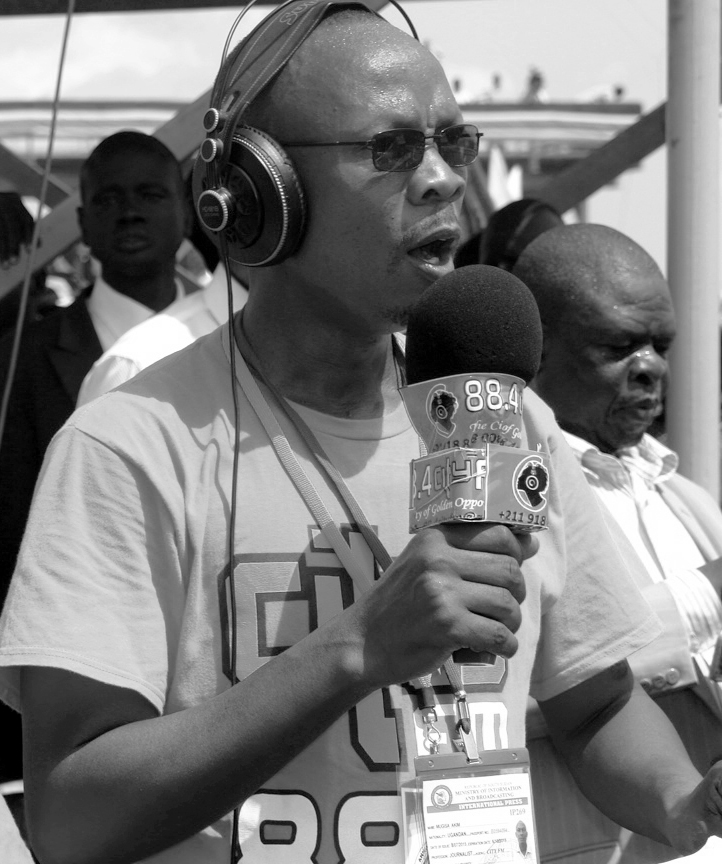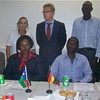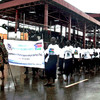Yei Town marks day for mine awareness and action
Each year, over 160 countries affected by landmines and explosive remnants of war across the world hold various activities to observe the 'International Day for Mine Awareness and Assistance in Mine Action'.
According to Pol Pot, a leader in the Cambodian Communist Movement, A mine is a perfect soldier, does not need food or water, does not take any salary or rest but lies in wait for its victim for thirty years or more”.
There are an estimated 500.000 survivors of landmines and explosive remnants of war with a particularly large number in Iraq, Afghanistan, Lebanon, Democratic Republic of Congo, Vietnam, Cambodia and not forgetting our motherland Sudan. It's important to note that the landmines are predominantly produced in the USA, Russia, India, China and Germany. Germany also being the funding source for sudanvotes.com. So why are they also manufacturing landmines you might ask?

A sign used to warn people of mines
I would therefore say The 2001 Ottawa Anti personnel Mines Ban Convention (APMBC) that prohibits production, use and stocking by signatories to the treaty came late when millions of the deadly devices had already been purchased officially or on black market and planted in battle fields by government forces or rebel movements in many countries where they have wrecked havoc with more of their next victims still unknown and unaware. Sudan is one of the states that ratified the Ottawa treaty that requires member states to report annually to the United Nations location of mine fields.
Through United Nations Development Programme (UNDP) agencies, the problem of Mines and UXOs especially in South Sudan has been given attention even before the signing of the Comprehensive Peace Agreement in 2005. Although establishing the actual statistics of victims of the devices is hard, a number of civilians, national demining personnel, expatriates and livestock have been killed and others maimed by mines and vehicles destroyed by the explosives that were planted between 1991-94 in Greater Equatoria that was the epicenter of the protracted civil war between the Khartoum government and the former rebels of Sudan People’s Liberation Army.
Among the latest victims was a 17 year old boy identified as Towongo whose leg was blown off below knee-level in Yari Boma, Mugwo Payam 18 miles Yei - Kaya road this month as he grazed domestic animals from which the family raises his school fees and livelihood. Five years after the end of Africa’s longest civil war in Sudan, we are still potential victims of thoussands of unexploded active landmines and ordinances littered across Sudan. Representatives of International and National Mine Action Groups on March 30th gathered at Yei Freedom Square to observe the second anniversary of the International Day for Mine Action and Assistance to Mine Action with a call for support from local authorities and communities if the region is to be freed from the risk of the existing mines and unexploded ordinances.
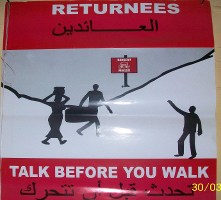
A sign in Yei used to warn returnees of landmines
Speaking during the celebrations held under the theme: Assistance to Mine Action” Batali Gabriel Modi, the Programme Officer, Norwegian People’s Aid-NPA Mine Action noted that mines were active soldiers who do not need facilitation but remain ready to kill, maim and destroy. Batali Gabriel Modi called for cooperation of the authorities and communities with survey and field mechanical clearance teams during de-mining activities and decried the behaviour of some SPLA officers who disobey instructions by de-mining teams during operations leading to accidents. The Programme Officer disclosed that at least 294 anti personnel mines, 28 Anti tank mines and over 3350 unexploded ordinances had been cleared in the period between January and March 2010. The Technical Field Manager for Mine Action Group-MAG, Akech Atheu Madol said his organization that joined Operation Save Innocent Lives an indigenous Mine Action in 1998 was now operating in five Southern States in Greater Equatoria and Blue Nile with ten technical and manual teams in areas of Yei, Kapoeta and Juba.
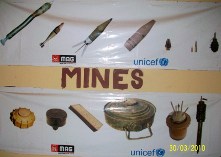
UNICEF poster showing people the variety of mines
Akech Atheu Madol said the cooperation would continue until the region is declared free of the mines threat adding that Sudanese themselves would be able to address the problem in the coming years following the building of their capacities by the international Mine Action groups. He called upon government to commit resources towards de-mining activities when the international bodies phase out their operations in Sudan. He said all equipment ranging from detectors, armored cars and other mine proof vehicles would remain in the hands of Operation Save Innocent lives-OSIL when the international groups wind up their programmes in the country next year. OSIL is currently carrying out awareness campaigns in communities through the Mine Risk Education component as well as providing assistance to victims by building their capacities and provision of agricultural inputs to enable them use land that has been cleared and declared mine-free.
Other International and National Mine Action operating in South Sudan include; Armour Group, MineTech, UNMAO, UNICEF and South Sudan De-mining Commission. According to MAG Technical Field Officer, over 46.000 unexploded Ordinances-UXOs had been recovered and destroyed, 460 anti-personnel and 130 anti tank mines uprooted while over 10 Square miles of land have been cleared and ready for agricultural activities and other developmental land use since June 2009 to date.
COMMITMENT MADE BY LOCAL AUTHORITIES
The Commissioners in the Counties of Yei and Lainya pledged commitment and cooperation with Mine Action Groups to ensure timely information flow from the communities on the existence of Explosive Remnants of War.
David Lokonga Moses of Yei River County while speaking at the Freedom Square during a function to celebrate the second International of Mine Action also asked the international community to increase the support to national staffs in areas of capacity building and mine risk awareness in communities. Lokonga urged the national technical staff to step up efforts in identifying affected areas and making them safe to enable the return of refugees and internally displaced persons so that they can settle and engage in agricultural activities for sustainable crop production.

A MAG Mine Clearance Team ready to risk their lives
The Commissioner for Lainya County, Samuel Suba Manasse who was chief guest, noted that the war of guns had ended years ago but mines remain active in fields, roads and schools in Greater Equatoria which was a centre of military operations during the two decade civil war.
Samuel Suba Manasse said the mines which were planted mainly by the Sudanese Armed forces (SAF) between 1991 and 94 still pose a big threat to the returning populations who may be victims if the devices are not removed. He urged the police and the army to volunteer information on the explosives adding that South Sudan Demining Authority should notify the SPLA command of the interference by members of the forces in the work of de-miners. Samuel Suba Manasse however noted that demining operations were limited to main roads while feeder roads like Kajokeji-Limbe and others were still infested and may hinder SPLM government vision of taking towns to the people in rural areas. He added that there was need to focus on rehabilitating victims of mines who were incapacitated by the exploding devices. While commenting on the upcoming elections, the Commissioner urged the voters to choose leaders who would not propagate mines in the region again.
Lainya County was identified to be having the highest number of mine fields in areas of Kenyi, Loka, Ganji and Bungu along Yei-Juba road and Kuruki on Juba-Kajokeji road while Morobo County is no exception. The threat of mines along the 100 miles Yei-Lainya-Juba road can be evidenced by a dozen of deminers’ camps and warning billboards by the road sides that caution motorists and pedestrians to stay in their tracks if they are to remain alive and reach their destinations safely.
The regional coordinator, South Sudan Demining Authority, Joseph Ramba Simon observed that it was a collective responsibility to ensure the threat of mines is reduced through use of existing systems handled by National Mine Action workers, expatriates and the available equipment if progress in social and economic development in the communities is to be realized. Joseph Ramba Simon also conveyed condolences to families whose beloved ones were killed or maimed by the mines including personnel involved in accidents during demining activities.
The occasion was graced with the display of demining equipment and armored cars as well as demonstration on handling and evacuation of injured personnel during operations. Mines and UXOs hurt us all, let us immediately report to the relevant authorities any suspicious objects without tempering with them and most especially heed to warnings and advices by the technical teams in the demining activities so that we can be able to see another sunrise each day.
